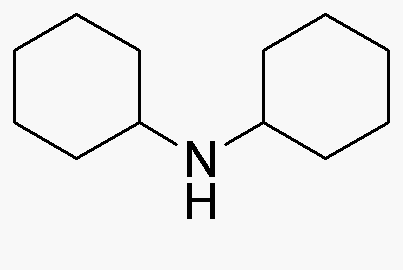Dicyclohexylamine is widely utilized in research focused on:
- Corrosion Inhibitors: This compound is effective in formulating corrosion inhibitors for metals, particularly in the oil and gas industry, helping to extend the lifespan of equipment and reduce maintenance costs.
- Rubber Industry: It serves as a curing agent in the production of rubber, enhancing the durability and performance of rubber products used in automotive and industrial applications.
- Pharmaceuticals: Dicyclohexylamine is used as an intermediate in the synthesis of various pharmaceuticals, contributing to the development of effective medications.
- Agrochemicals: It plays a role in the formulation of herbicides and pesticides, improving their efficacy and stability, which is crucial for agricultural productivity.
- Surfactants: This compound is utilized in the production of surfactants, which are essential in detergents and cleaning products, enhancing their cleaning power and efficiency.
General Information
Properties
Safety and Regulations
Applications
Dicyclohexylamine is widely utilized in research focused on:
- Corrosion Inhibitors: This compound is effective in formulating corrosion inhibitors for metals, particularly in the oil and gas industry, helping to extend the lifespan of equipment and reduce maintenance costs.
- Rubber Industry: It serves as a curing agent in the production of rubber, enhancing the durability and performance of rubber products used in automotive and industrial applications.
- Pharmaceuticals: Dicyclohexylamine is used as an intermediate in the synthesis of various pharmaceuticals, contributing to the development of effective medications.
- Agrochemicals: It plays a role in the formulation of herbicides and pesticides, improving their efficacy and stability, which is crucial for agricultural productivity.
- Surfactants: This compound is utilized in the production of surfactants, which are essential in detergents and cleaning products, enhancing their cleaning power and efficiency.
Documents
Safety Data Sheets (SDS)
The SDS provides comprehensive safety information on handling, storage, and disposal of the product.
Product Specification (PS)
The PS provides a comprehensive breakdown of the product’s properties, including chemical composition, physical state, purity, and storage requirements. It also details acceptable quality ranges and the product's intended applications.
Certificates of Analysis (COA)
Search for Certificates of Analysis (COA) by entering the products Lot Number. Lot and Batch Numbers can be found on a product’s label following the words ‘Lot’ or ‘Batch’.
*Catalog Number
*Lot Number
Certificates Of Origin (COO)
This COO confirms the country where the product was manufactured, and also details the materials and components used in it and whether it is derived from natural, synthetic, or other specific sources. This certificate may be required for customs, trade, and regulatory compliance.
*Catalog Number
*Lot Number
Safety Data Sheets (SDS)
The SDS provides comprehensive safety information on handling, storage, and disposal of the product.
DownloadProduct Specification (PS)
The PS provides a comprehensive breakdown of the product’s properties, including chemical composition, physical state, purity, and storage requirements. It also details acceptable quality ranges and the product's intended applications.
DownloadCertificates of Analysis (COA)
Search for Certificates of Analysis (COA) by entering the products Lot Number. Lot and Batch Numbers can be found on a product’s label following the words ‘Lot’ or ‘Batch’.
*Catalog Number
*Lot Number
Certificates Of Origin (COO)
This COO confirms the country where the product was manufactured, and also details the materials and components used in it and whether it is derived from natural, synthetic, or other specific sources. This certificate may be required for customs, trade, and regulatory compliance.


